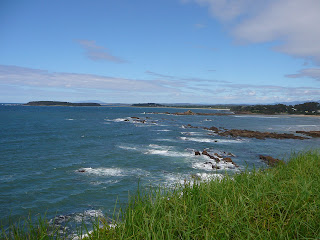Our three weeks at Cabarita Beach has gone quickly. Our final week there began overcast and wet. Much of New South Wales and Northern Victoria are in the grip of floods as heavy summer rains have overloaded the systems of the Darling, Murrumbidgee, Goulburn and Broken Rivers. In a few weeks vast amounts of water will also move into the mighty Murray River. Whole towns have been evacuated as floodwaters inundate properties and homes. On the North Coast we have been spared the torrential rain experienced further south over last few weeks, and apart from a few wet days we have been blessed with sunshine.
Saturday 3rd March was overcast so we decided to drive to Tumblegum (pronounces Toom-booool-gm, NOT Tumble-gum) for lunch at the Tavern. One of our fellow travellers recommended it to us and we had a delicious shepherd's pie for lunch. Our walk through the town was cut short by rain so we decided to head back to our apartment to watch some DVDs.
Sunday was sunny so we explored the markets at nearby Pottsville. This market had pretty much the same stalls as the Kingscliff markets we saw the previous week. As with last week, we bought some delicious samoses and chilli filled olives.

 Most of the week was spent relaxing and swimming in the resort pool - a great life. Cabarita Beach has a headland which juts out into the sea, separating the beaches. The beach on the town side is popular with surfers and there were at least 50 in the water each day. Most of them seemed to congregate just past the breakers and paddle around chatting. There were only a few who seemed to do any surfing. The views from this high point are spectacular along the coast and inland to the mountains.
Most of the week was spent relaxing and swimming in the resort pool - a great life. Cabarita Beach has a headland which juts out into the sea, separating the beaches. The beach on the town side is popular with surfers and there were at least 50 in the water each day. Most of them seemed to congregate just past the breakers and paddle around chatting. There were only a few who seemed to do any surfing. The views from this high point are spectacular along the coast and inland to the mountains.
The vegetation around the headland is coastal banksias and palm trees which have large segmented seed pods.

Thursday was a nice sunny day so we went back to Tumblegum to take some photos. Tumblegum is on the Tweed River and is about halfway between Cabarita Beach and Murwillumbah. It's quite a historic town and you can hire houseboats to holiday on the river. The Tavern was built in 1857 and there are several old buildings in the town, including a church which is for sale. We spent some time browsing in the Gallery which has many artworks by local artists. We were very taken by some of the furniture which was beautifully made and which would fit in with our existing furniture. A pity we don't have anywhere to put it - or maybe it was a good thing as we might have been tempted to make some purchases. The Tweed River and Tumbulgum are not immune to flood, although recent floods have not been as high as the 1954 flood level.

Tumblegum is also the birthplace of Faith Bandler (nee Mussing) A.M. who was a co-founder of the Aboriginal Australian Fellowship which was responsible for removing the legislation discriminating against aboriginals in 1967. She has a long list of distinctions including an Order of Australia. There's a park named after her and a memorial stone with a plaque.
Friday 9th March and we've said goodbye to Tamarind Sands and Cabarita Beach and we're heading south towards Sydney. We have driven about 550km today past macadamia nut, sugar cane and banana plantations. We're staying at Forster which is on Wallis Lake in the Myall Lakes region for a couple of days before we drive to Sydney on Sunday.



























































